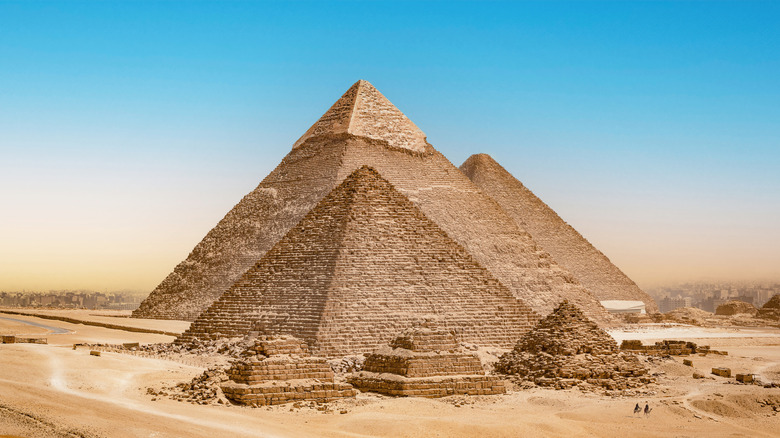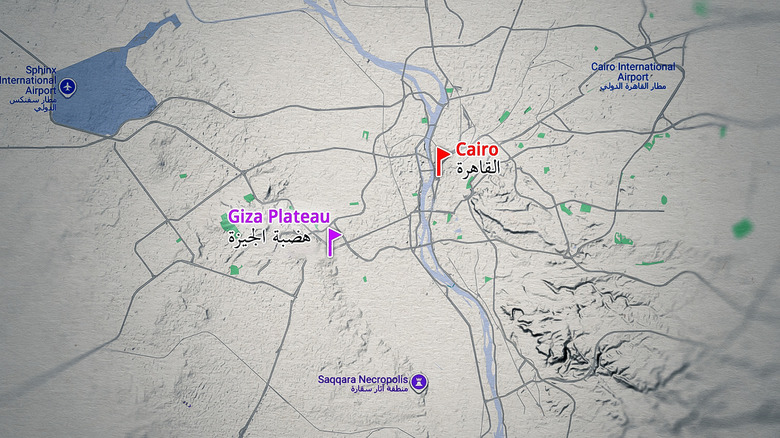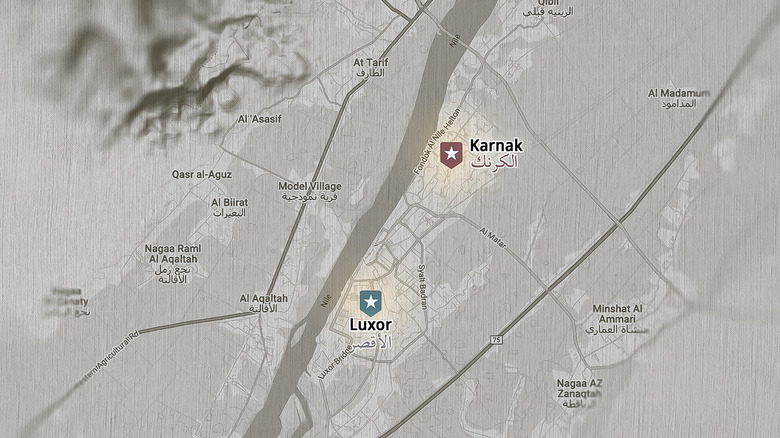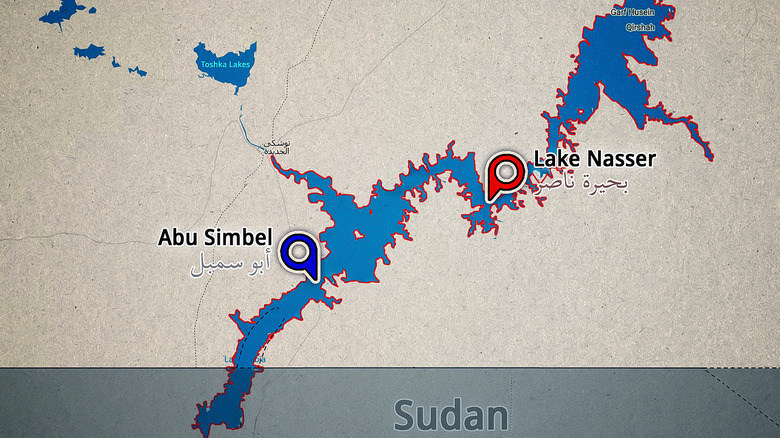The Only Map Of Egypt You Need For Your Upcoming Trip
Tourists have been marveling over the pyramids and temples of ancient Egypt for longer than you might imagine. Greek historian Herodotus wrote about his travels there in the 5th century B.C.E. One of the world's first travel writers, Pausanias, told readers about the pyramids in addition to his recommendations in Greece in the 2nd century C.E. Napoleon Bonaparte's army even left graffiti on the monuments. Though the ancient Egyptian culture once ruled by pharaohs began around 3100 B.C.E., it's still a draw today. In fact, in 2024, 15.7 million people traveled to the country, according to Egyptian government officials. However, there is more to Egypt than just the Pyramids of Giza and the Great Sphinx.
While the astonishing ancient structures are unmissable when you visit, there is also the brand new Grand Egyptian Museum (which took almost as long to open as it took to build the pyramids) to experience, the beautiful Al-Azhar Mosque, hot air balloon rides over the Nile, and even the Bibliotheca Alexandrina, a new library created in the spirit of the ancient Library of Alexandria, founded by Alexander the Great. (There is also the Western Desert and the Sinai Peninsula; however, with a safety advisory in place from the U.S. State Department as of this writing, we won't be covering those areas.) To navigate the best sites, here is the only map of Egypt you'll need for your upcoming trip.
Northern Nile: Alexandria, Dahshur, and Saqqara
While you may consider heading right to see the pyramids, don't skip Alexandria. The city on the northeast shore of Egypt was founded in 332 B.C.E. by Alexander the Great and was the home base to many philosophers and scholars. It once boasted the Library of Alexandria, a structure that is said to have contained many of the ancient world's books. While it was lost long ago, you can visit the Bibliotheca Alexandrina, a new version that celebrates its famous predecessor. You can walk along the curving Alexandria Corniche and take in the shoreline and the multi-domed Abu al-Abbas al-Mursi Mosque, see Pompey's Pillar and the Serapeum, or visit the beautifully carved Catacombs of Kom El Shoqafa, while marveling that your feet are treading on the same place as the conqueror of much of the ancient world.
Before you visit the famous pyramids at Giza, you should take a trip to see some structures that are even older. The Dahshur necropolis here boasts the Bent and Red pyramids. The Bent Pyramid was built for Pharaoh Sneferu, but it didn't go as planned. This over four-and-a-half-millennia-old structure doesn't conform to the usual shape, bending in about halfway up. The Red Pyramid, also built for Sneferu, is the third largest in Egypt, though it was once white. There is also the ruin of the 3,800-year-old Black Pyramid nearby, though while you can go inside the first two, you can't go in the third. Still, its outline is fascinating and quite haunting. While you're in Saqqara, you should also travel down the road of sphinxes to the Serapeum, which is the final resting place of the sacred Apis bulls. These massive hallways and tombs are a marvel to behold.
Northern Nile: Cairo and the Giza Plateau
Cairo is a must with its bustling markets, like the Khan el-Khalili Bazaar, and the new Grand Egyptian Museum, featuring artifacts from King Tutankhamun's tomb. (Double-check whether it's open before you go, as it's had quite a few shifting dates.) However, the jewel in the crown of this country is the Giza Plateau. The Great Pyramid, built as a tomb for Pharaoh Khufu who died in 2566 B.C.E., is one of the Seven Wonders of the Ancient World. It stands alongside the pyramids built for his son and grandson, Khafre and Menkaure respectively. You can take a camel or horse ride there and go inside these structures (for an additional fee) that were ancient even in the reign of Queen Cleopatra. The mysterious Great Sphinx is near a viewing platform with the perfect spot for pictures. At night, you can purchase tickets to a sound and light show at these ancient structures.
If you're looking for something a bit more lively, take a boat to Gezira Island to walk through and dine in upscale neighborhoods, and see the Cairo Tower and Opera House. It's also worth visiting Al-Azhar Mosque, one of the oldest in the country, and its attached Al Azhar University. However, keep in mind that Cairo is more dangerous than you might think. Keep the country's dress code and mores in mind, and stay abreast of the political situation before you venture out.
Southern Nile: Luxor and Karnak
Farther south on the Nile, you can visit the ancient city of Thebes, now called Luxor, full of temples and tombs. While the downtown area is modern, it's likely the ruins you want to see. Luxor Temple was built and expanded over the years during the reins of luminaries like Queen Hatshepsut and Amenhotep III. The Luxor Museum is also worth a stop to see incredible artifacts that were found at the Temple of Luxor and the Karnak Temple Complex. Set aside more than a single day to see the Karnak Temple. This incredible complex houses gems like the First Court shrines attributed to Nectanebo I, who reigned from 380 to 362 B.C.E. You can visit the Festival Hall of Tuthmosis III and find the hidden obelisks of Hatshepsut, whose stepson and co-regent tried to erase all signs of her rule after her death.
Next is the Valley of the Kings, where pharaohs were buried between the 18th and 20th dynasties. This is where King Tutankhamun was found, and where Ramses II is buried. Over 60 tombs were excavated here, and you can visit a number of them, though some carry an extra fee. South of the Valley of the Kings is the Valley of the Queens, where Queen Tuy, Queen Nefertari, and the sons of Ramses III were entombed dating back to the 18th Dynasty. Here you'll find gorgeous artwork inside, particularly in QV55, the Tomb of Amenherkhepshef.
You should also make time to visit the beautiful temple of Hatshepsut in Deir-el-Bahri with its shrine and chapels. In addition to the beauty, you can again see how pains were taken to erase her from history. To experience this all a different way, try a hot air balloon ride over the Nile at sunrise.
Abu Simbel and Lake Nasser
Close to the southern border between Egypt and Sudan, you'll find the massive Abu Simbel temple complex built by Ramses II. Aside from the fact that this 13th-century B.C.E. temple complex is astonishing to see, its very existence is a marvel. When the Aswan High Dam was created in the 1960s, a UNESCO team moved the entire thing, piece by piece over five years, to where it now sits, saving it from the water (and the resulting reservoir of Lake Nasser). There is a visitor center that gives you some information about how they accomplished this wild feat. There are four massive statues of Ramses in the front that have to be seen to be believed. You'll also find the Temple of Hathor there that the pharaoh built to honor his wife Nefertari. This place is enormous, and it's easy to be overwhelmed, but don't miss the vestibules, with incredible decoration and carvings.
Lake Nasser may be a newer feature on the Egyptian landscape, but you can get a real sense of the area by taking a lake cruise from Aswan (near the northern tip of the lake) that stops at several temples, including the complex at Abu Simbel. Some of them are several days long. If you decide to drive, do note that Abu Simbel is a three-hour drive from Aswan, and the roads aren't open all the time. You may also hit police checkpoints, so you might want to take a tour rather than driving yourself. You can also choose to fly in from Aswan and take a shuttle. Despite the fact that Abu Simbel is around 700 miles from Cairo, it's one of Egypt's most famous attractions for a reason.




